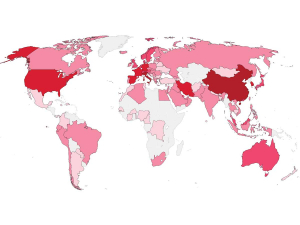MPI launches industry-wide project to manage feral deer
An industry-wide project led by Ministry for Primary Industries (MPI) is underway to deal with the rising number of feral pests, in particular, browsing pests such as deer and pigs.
 With over 130,000 cases worldwide Coronavirus isnow a pandemic. Dark areas have more than 10,000 cases.
With over 130,000 cases worldwide Coronavirus isnow a pandemic. Dark areas have more than 10,000 cases.
Covid-19 is forecast to strip more than $1.3 billion dollars off New Zealand’s primary exports in the coming year, including $390 million off dairy exports.
This latest revelation comes in the Ministry for Primary Industries latest Situation and Outlook Report, released late last week.
In December MPI were forecasting that primary exports for the year ending June 2020 would be $47.8 billion – now this has been reduced to $46.5 billion, a mere 0.5% up on the 2019 total. It is also warning of further downward revisions. The report came out the day World Health Organisation declared coronavirus a pandemic.
The report states that while the geopolitical tensions on trade such as Brexit and the US-China trade war have eased somewhat, coronavirus has added new uncertainty for NZ primary exporters. It notes that the seafood and forestry sectors have been particularly badly hit. But it points in the last month dairy commodity prices have softened and the average price on the GDT fell 7.5%.
It says there has been weakness in milk powders, butter, and anhydrous milk fat. However, despite the disruptions in Chinese markets, North Asian buyers have continued to be active in recent auctions, with volumes traded higher than at the same time the previous year. It adds that prices for cheese and casein have continued to strengthen.
MPI predicts that continued declines in key commodity prices will impact farm gate milk price payouts but it says given the strength of current export prices, strong payouts are still likely and will continue to support dairy farmer profitability this season. It say an average payout of $7.15/kgMS is likely.
Fonterra will announce its half-year results this week: coronavirus is likely to have an impact.
Accoriding to MPI, while revenue from the dairy sector is down on the December forecast, it is still ahead of the previous year and is expected to earn about $19.2 billion. The report also notes that despite the drought in the major dairying regions milk production for the first eight months of the season was up by point five of a percent.
Meat and horticulture exports have also taken a hit with revenue from meat down by $220 million and horticulture by $110 million.
The as yet unknown factor says the report is the fate of the NZ dollar which has already weakened since the beginning of this year. MPI says should the weakening in our key agricultural commodity prices continue to worsen, they would expect further adjustments in the NZ$ to help offset some of these effects for primary sector exporters. And MPI warns further revisions downward in future forecasts are likely.
The National Wild Goat Hunting Competition has removed 33,418 wild goats over the past three years.
New Zealand needs a new healthcare model to address rising rates of obesity in rural communities, with the current system leaving many patients unable to access effective treatment or long-term support, warn GPs.
Southland farmers are being urged to put safety first, following a spike in tip offs about risky handling of wind-damaged trees
Third-generation Ashburton dairy farmers TJ and Mark Stewart are no strangers to adapting and evolving.
When American retail giant Cosco came to audit Open Country Dairy’s new butter plant at the Waharoa site and give the green light to supply their American stores, they allowed themselves a week for the exercise.
Fonterra chair Peter McBride says the divestment of Mainland Group is their last significant asset sale and signals the end of structural changes.